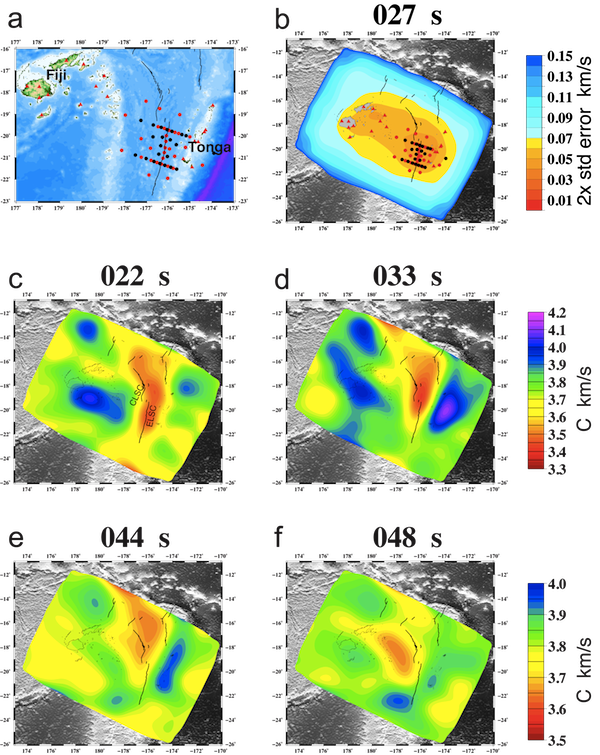2012 IRIS Workshop
The Seismic Structure of the Lau Backarc Spreading Center from Rayleigh Wave Tomography
Songqiao Shawn Wei: Washington University in St. Louis, Douglas A. Wiens: Washington University in St. Louis
(a) Topography and bathymetry of the studied region and locations of seismic stations used in our study. Red triangles represent land seismic stations operated from Oct. 2009 to Dec. 2001. Red and black dots are LDOE and WHOI OBSs deployed from Nov. 2009 to Oct. 2010, respectively. Black lines indicate the spreading centers. (b) Standard error contours of 2-D phase velocity results for period of 27 s. (c) – (f) 2-D phase velocity maps at periods of 22 – 48 s. The central Lau spreading center (CLSC) and eastern Lau spreading center (ELSC) are labeled in (c).

Full-resolution graphics file in original format: 0010.png
We use the two-plane wave method of Rayleigh wave phase velocity tomography including finite-frequency effects to analyze seismic data from 52 ocean bottom seismographs and 18 land-based seismic stations deployed in Fiji, Tonga, and across the Lau basin. Preliminary results show that the slow velocity anomalies extend along the spreading centers with a N-S striking variation. Although temperature dominates the seismic properties in the Lau basin, smaller-scale seismic anomalies are interpreted in terms of partial melting. The asymmetric and broad distribution of partial melt in the mantle across the Lau basin implies the passive decompression melting process. The variations along the spreading centers indicate the various depths and in-situ melt contents beneath the central Lau spreading center (CLSC) and the eastern Lau spreading center (ELSC). Deeper slow anomalies to the west of the ELSC and CLSC suggest initial partial melting during asymmetric upwelling governed by the backarc mantle flow pattern, and shallower slow anomalies showing melting along a continuous band to the east of the CLSC. The slowest velocities are found in the northern part of the study region, where the backarc spreading rate is faster. The Pacific subducting slab, the Fiji plateau, and the Lau ridge are all characterized by high velocity anomalies, with the latter two regions showing evidence of cold and refractory island arc lithosphere.
Acknoweldgements: We thank Patrick Shore and all other field workers of the EPSL project. David Heeszel, Garratt G. Euler, and Yingjie Yang provided great help on data processing. In addition, we thank Katherine A. Kelley, Philip Skemer, and Brandon Mahan for constructive discussions on seismic interpretations. This research was funded by NSF Grant OCE-0426408.
Keywords: rayleigh_wave_tomography, lau_backarc_basin, partial_melting
